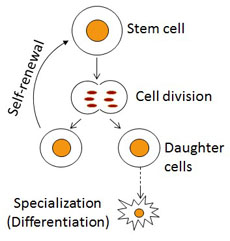What are stem cells,
and why are they important? (Blog post #1)
Stem cells are cells that are able
to develop into many different types of cells in the body. They also serve as
repair mechanisms in tissues by undergoing cell division almost without limit
to help replenish any damaged or dead cells. Whenever a stem cell divides, each
new cell can either become another stem cell or differentiate into a specific
type of cell, such as a muscle, brain, or red blood cell. The reason stem cells
are significant is because they possess two unique characteristics: 1) they are
unspecialized cells that can self-replenish through cell division even after
inactivation, and 2) if they are put under certain environmental and physiological
conditions, they can be induced to become certain types of cells, depending on
the tissue or organ. These properties of stem cells allow for potential
research and testing into treating and curing various diseases involving
damaged or malfunctioning tissues and organs.


There are two main ways that stem
cells are acquired: embryonic stem cells and non-embryonic (“somatic” or
“adult”) stem cells. Embryonic stem cells are derived from embryos that have
developed in eggs in vitro (meaning
in laboratory settings) and not in a woman’s body. These cells are then
cultured, grown, and stored for later use. Through the process of “directed
differentiation,” scientists are able to control how the cells differentiate by
changing the chemical construct of the medium that the cells are grown in, as
well as by inserting specific genes into the cells. This way, the stem cells
can be grown at will into any type of cell needed. Adult, or somatic, stem
cells are undifferentiated cells that are found in the matured tissues of
adults. These cells are mainly used for repairing damaged or dying tissue, and
can be used in similar ways as embryonic stem cells. Usually, somatic stem
cells are found in areas such as bone marrow, as well as in the brain and
heart. This provides for the opportunity to use one’s own stem cells to help
treat one’s disease, instead of using an embryo’s stem cells and have the
potential risk of rejection.
Link for
this discussion:
American
Medical Association
I think research/clinical use of non-embryonic stem cells will have a much higher level of popularity and support. I look forward to reading and learning more about this topic..
ReplyDelete